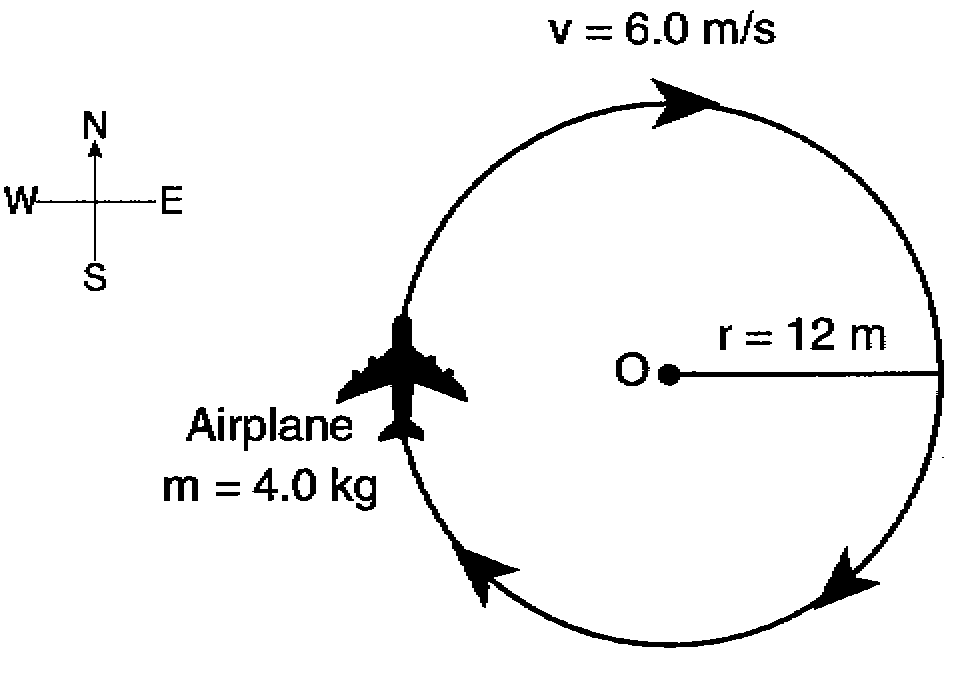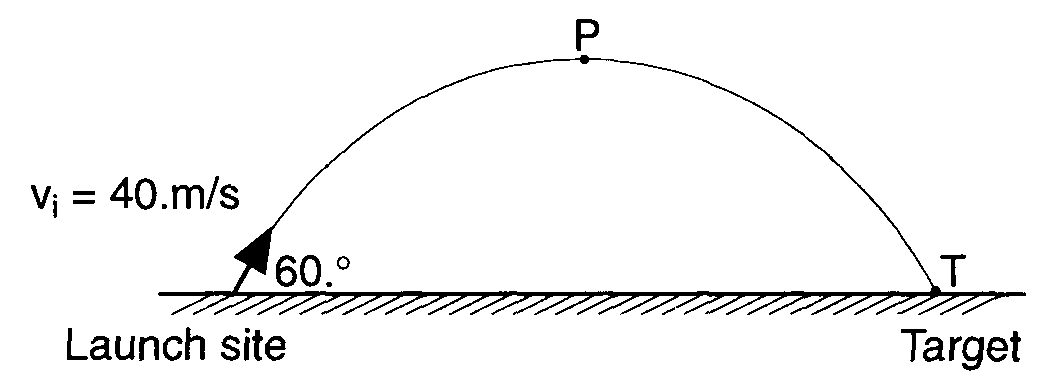1.![]() An object travels in a
circular path of radius 5.0 m at a uniform speed of 10. m/s. What is the magnitude
An object travels in a
circular path of radius 5.0 m at a uniform speed of 10. m/s. What is the magnitude
![]() of the object's centripetal
acceleration ?
of the object's centripetal
acceleration ?
![]() 10. m/s2
10. m/s2![]() 2.0 m/s2
2.0 m/s2![]() 5.0 m/s2
5.0 m/s2![]() 20. m/s2
20. m/s2
2.![]() A 1 kg object is thrown
horizontally and a 2 kg object is dropped vertically at the same instant and from the
A 1 kg object is thrown
horizontally and a 2 kg object is dropped vertically at the same instant and from the
![]() same point above the ground. If
friction is neglected, which object will hit the ground first ?
same point above the ground. If
friction is neglected, which object will hit the ground first ?
![]() 1 kg object
1 kg object![]() 2 kg object
2 kg object![]() both hit the ground at the same time
both hit the ground at the same time
Base your answers to questions 3 through 7 on the diagram below which shows a rock being thrown off a cliff with an initial horizontal velocity of 20. m/s east. (Disregard air resistance)

3.![]() How long does it take the rock
to hit the ground ?
How long does it take the rock
to hit the ground ?
![]() 4.5 s
4.5 s![]() 20. s
20. s![]() 2.0 s
2.0 s![]() 3.2 s
3.2 s
4.![]() What is the initial vertical
component of the rock's velocity ?
What is the initial vertical
component of the rock's velocity ?
![]() 0 m/s
0 m/s![]() 5.0 m/s
5.0 m/s![]() 10. m/s
10. m/s![]() 20. m/s
20. m/s
5.![]() What is the horizontal speed
of the rock after falling for 1.0 s ?
What is the horizontal speed
of the rock after falling for 1.0 s ?
![]() 1.0 m/s
1.0 m/s![]() 100 m/s
100 m/s![]() 20. m/s
20. m/s![]() 9.8 m/s
9.8 m/s
6.![]() What is the vertical speed
of the rock after falling for 1.0 s ?
What is the vertical speed
of the rock after falling for 1.0 s ?
![]() 1.0 m/s
1.0 m/s![]() 100 m/s
100 m/s![]() 20. m/s
20. m/s![]() 9.8 m/s
9.8 m/s
7.![]() If the rock were thrown off
the cliff at 40. m/s east, what would increase ?
If the rock were thrown off
the cliff at 40. m/s east, what would increase ?
![]() vertical acceleration
vertical acceleration![]() time in the air
time in the air![]() horizontal distance
horizontal distance
Base your answers to questions 8 and 9 on the diagram below which shows a satellite orbiting the earth.

8.![]() Toward which
letter does the centripetal acceleration of the satellite point ?
Toward which
letter does the centripetal acceleration of the satellite point ?
![]() A
A![]() B
B![]() C
C![]() D
D
9.![]() Toward which
letter does the velocity of the satellite point ?
Toward which
letter does the velocity of the satellite point ?
![]() A
A![]() B
B![]() C
C![]() D
D
Base your answers to questions 10 and 11 on the diagram below which shows a toy airplane traveling in a circular path.

10.![]() If only the speed of the toy airplane were doubled, what would happen to the centripetal acceleration ?
If only the speed of the toy airplane were doubled, what would happen to the centripetal acceleration ?
![]() it would be halved
it would be halved![]() it would double
it would double![]() it would be quartered
it would be quartered![]() it would quadruple
it would quadruple
11.![]() What is the direction of
the centripetal acceleration of the toy airplane ?
What is the direction of
the centripetal acceleration of the toy airplane ?
![]() north
north![]() south
south![]() east
east![]() west
west
Base your answers to questions 12 through 16 on the diagram below which shows the
trajectory of a projectile launched
on the Earth's surface.

12.![]() What is the
initial vertical velocity of the projectile ?
What is the
initial vertical velocity of the projectile ?
![]() 35 m/s
35 m/s![]() 20 m/s
20 m/s![]() 40 m/s
40 m/s![]() 30 m/s
30 m/s
13.![]() What is the
initial horizontal velocity of the projectile ?
What is the
initial horizontal velocity of the projectile ?
![]() 35 m/s
35 m/s![]() 20 m/s
20 m/s![]() 40 m/s
40 m/s![]() 30 m/s
30 m/s
14.![]() If the angle
were decreased to 50o, the horizontal distance traveled by the projectile would
If the angle
were decreased to 50o, the horizontal distance traveled by the projectile would
![]() decrease
decrease![]() increase
increase![]() remain the same
remain the same
15.![]() What is the horizontal
velocity of the projectile at point P ?
What is the horizontal
velocity of the projectile at point P ?
![]() 35 m/s
35 m/s![]() 20 m/s
20 m/s![]() 40 m/s
40 m/s![]() 30 m/s
30 m/s
16.![]() What is the vertical
velocity of the projectile at point P ?
What is the vertical
velocity of the projectile at point P ?
![]() 35 m/s
35 m/s![]() 20 m/s
20 m/s![]() 40 m/s
40 m/s![]() 0 m/s
0 m/s
Base your answers to questions 17 through 21 on the information below.
A ball is thrown horizontally with a speed v from a height h above level ground.
17.![]() If the height above the
ground were increased, the initial vertical velocity of the ball would
If the height above the
ground were increased, the initial vertical velocity of the ball would
![]() decrease
decrease![]() increase
increase![]() remain the same
remain the same
18.![]() If the height above the
ground were increased, the time of flight of the ball would
If the height above the
ground were increased, the time of flight of the ball would
![]() decrease
decrease![]() increase
increase![]()
19.![]() If the initial speed of the
ball were increased, the time of flight of the ball would
If the initial speed of the
ball were increased, the time of flight of the ball would
![]() decrease
decrease![]() increase
increase![]() remain the same
remain the same
20.![]() If the initial speed of the
ball were increased, the horizontal distance traveled by the ball would
If the initial speed of the
ball were increased, the horizontal distance traveled by the ball would
![]() decrease
decrease![]() increase
increase![]() remain the same
remain the same
21.![]() If the initial speed of the
ball were increased, the vertical acceleration of the ball would
If the initial speed of the
ball were increased, the vertical acceleration of the ball would
![]() decerease
decerease![]() increase
increase![]() remain the same
remain the same
For questions 22 through 24 a projectile is fired at 25 m/s at 27o, 37o, 55o, and 63o. [Neglect air resistance.]
22.![]() At which angle will the
projectile reach the greatest height ?
At which angle will the
projectile reach the greatest height ?
![]() 27o
27o![]() 37o
37o![]() 55o
55o![]() 63o
63o
23.![]() At which angle will the
projectile travel the greatest horizontal distance ?
At which angle will the
projectile travel the greatest horizontal distance ?
![]() 27o
27o![]() 37o
37o![]() 55o
55o![]() 63o
63o
24.![]() At which angle will the
projectile spend the least time in the air ?
At which angle will the
projectile spend the least time in the air ?
![]() 27o
27o![]() 37o
37o![]() 55o
55o![]() 63o
63o